Introduction
Dwarf galaxies are small stellar structures with low surface brightness and low stellar content in relation to their total mass (Mateo, 1996); they are poor in metals since they are mostly composed of old stars (Da Costa, 1999). The importance of dwarf galaxies resides in that they are abundant in the local universe and constitute a fundamental tool to understand the formation processes and the evolution of larger galaxies given that, according to the model of hierarchical evolution, larger galaxies formed from mergers or accretion of smaller galaxies. Additionally, these dwarf galaxies are characterized by having low stellar masses, in the order of 107 to 108 solar masses (M⨀), in relation to their total masses estimated from their mass-luminosity ratio. This lack of luminous mass has been interpreted so far by the xistence of a dark matter halo of the order of 108 to 1010 M⨀ surrounding them (Mayer, 2010).
From the velocity dispersions in associations of dwarf galaxies, Tully, et al . (2006) concluded that their mass-to- light ratios exceed in order of magnitude the values for the globular clusters, which would indicate that a significant amount of dark matter dominates them. However, the high values of the mass-to-light ratios of dwarf spheroidal galaxies could be overestimated if we consider that these objects are not necessarily in virial equilibrium and could be considered as systems in quasi-equilibrium, so that the dwarfs would lack or have very little dark matter content (Casas, et al., 2012). Studying the Milky Way dwarf satellites has great importance given the discrepancy between the predictions of the cold dark matter cosmological model (ΛCDM) and the observational data: the predicted number of satellite dwarf galaxies of the Milky Way is much higher (of the order of hundreds) than the one currently detected in the observations, which is barely of ~40 members (Klypin, et al., 1999). Another important discrepancy has to do with the way these dwarf galaxies are distributed, which in the ΛCDM model should have an almost isotropic distribution around their host galaxy. However, from observations in the Milky Way, the galaxy of Andromeda, and, recently, the Centaurus A group (Müller, et al. , 2016; Tully, et al. , 2006), these dwarf galaxies present an inhomogeneous and anisotropic distribution (Metz, et al. , 2007), which corresponds to the Holmberg effect (Holmberg, 1969) The exploration of this phenomenon revealed that the satellite system associated to the Milky Way follows a spatial distribution mediated by a virtual plane called the disk of satellites (DoS) (Metz, et al. , 2008), more recently renamed as vast polar structure of satellites (VPOS), which includes other objects detected in the last decade such as the ultra-faint dwarf galaxies (UFDG) (Pawlowski, et al., 2012). This disk structure, composed of satellite dwarf galaxies, lies in a geometric plane that forms an angle of approximately 88° with the plane of the galactic disk and has a galactocentric mean radius of hundreds of kiloparsec. Metz, et al. (2008) have shown that the CDM satellite orbital poles are fully consistent with being drawn from a random distribution, while the MW satellite orbital poles indicate that the DoS of the Milky Way is rotationally supported, which probably indicates that the majority of them are of tidal origin rather than being dark matter-dominated structures. Metz, et al. (2009) investigated the selection bias introduced due to the limited sky coverage of the Sloan Digital Sky Survey (York, et al. , 2000). They found that the new Milky Way satellite galaxies follow closely the DoS defined by the more luminous dwarfs, thereby further emphasizing the statistical significance of this feature in the Galactic halo. Angus, et al. (2011) performed MOND N-body simulations of a Carina-like dSph orbiting the Milky Way and found that the simulated galaxies are stable, but that the tidal forces are not enough to artificially inflate their line-of- sight velocity dispersions. Bohórquez & Casas-Miranda (2016) found from N-body numerical simulations that a collision between two disk galaxies can recreate a structure like the DoS, but that the characteristics of the structures obtained are not similar to those reported in the literature. Casallas (2014) showed that the dynamical friction from the dark matter halo of the Milky Way is too weak, so that objects initially following circular orbits with initial radii ~1 Mpc cannot fall into the Milky Way during a Hubble time. Therefore, the issue about the origin and dynamics of the DoS or VPOS continues to be an open question in today’s astrophysics, and constitutes one of the main motivations for the development of this work, since studying and under- standing the formation models of the disk of satellites would allow to better address investigations on its origin, as well as the search for new objects that could belong to this structure. We present here the results of a set of numerical N-Body simulations for the infall of an association of dwarf galaxies towards the Milky Way following parabolic orbits. Some preliminary parts of the research work shown in this paper have been published in proceedings (Benavides & Casas Miranda, 2017; Benavides & Casas-Miranda, 2018). More details about this work can be found in the Master’s thesis of Benavides, (2015).
Methodology
Generation of objects and interaction environment. Metz, et al. (2009) considered the possibility that the dwarf galaxies that make up the satellite disk had precipitated into the Milky Way halo in associations rather than in an individual way, so that the spatial distribution exhibited by this structure is directly related with the infall direction of these associations. In this work, we considered a model in which the dwarf galaxies grouped in associations and located in regions peripheral to the Local Group were precipitated by gravitational interaction towards the dark matter halo of the Milky Way following a parabolic orbit, taking into account the interaction of the dwarfs with the halo of the host galaxy, the interaction between them, and the evolution of their spatial distribution during the infall. For this, we performed a set of Newtonian N-Body numerical simulations. We used the ZENO code package (Barnes, 2018) from the Institute for Astronomy of the University of Hawaii, to generate the astrophysical objects, and the GADGET software (Springel, 2005) to simulate the gravitational interactions.
Since the dwarf galaxies that are part of the disk of satellites of the Milky Way are mostly of the spheroidal type (Da Costa, 1999; Tully, et al., 2006), we modeled them as bodies with spherical symmetry specifically using the Plummer profile (Plummer, 1911), the Hernquist profile (Hernquist, 1990) and the NFW profile (Navarro, et al. , 1996).
The stellar component of the dwarf galaxies was modeled using a Plummer profile with a radial gravitational potential of the form:
where r is the radial distance from the center, b is the Plummer radius and M is the total mass.
To model the dark matter haloe we used a spherical Hernquist profile, whose potential is:
where G is the Cavendish constant, M is the total mass and a is a parameter that depends on the scaling length r s and the concentration c of the Navarro-Frenk-White profile of the dark matter halo (Springel, et al. , 2005):
We used the stellar mass and dark matter halo parameter values following Sawala (2011), and Plummer’s radius and softening length following Casas, et al. (2012) (Table 1).
Table 1 Assigned values for the model of a dwarf spheroidal galaxy with a Plummer profile and a dark matter halo following a Hernquist profile
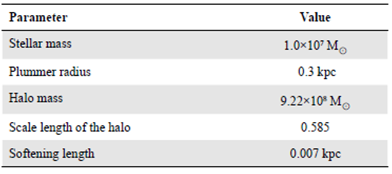
Since the presence of dark matter in the dwarf spheroidal galaxies (dSphs) of the Milky Way is still under debate, we performed our simulations with initial dwarfs both with and without a dark matter halo to study the possible differences in the final distribution and structure of the remnant objects.
We simulated the host galaxy by an object resembling the Milky Way and its main features and components: Central spheroid, stellar disk and dark matter halo, the latter being the one that would bring the largest interaction with the group of dwarf galaxies due to its contribution in mass and size.
For the model of the disk we used an exponential density profile of the form (Springel & White, 1998):
where R and z are the cylindrical coordinates, Md is the mass of the disk, Rd scale length, and zo is the vertical scale length.
For the central spheroid and the dark matter halo, we used a spherical Hernquist profile. The parameters used are presented in Table 2.
Table 2 Values assigned to the model of a disk galaxy with the characteristics of the Milky Way, which conform to those presented by Metz, et al. (2009)
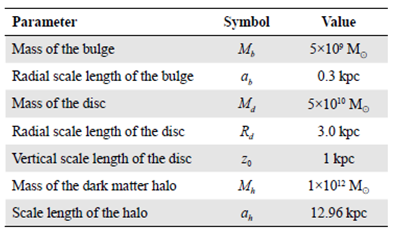
Before simulating the gravitational interaction between the initial dwarfs and the host galaxy, they were simulated separately only under their self-gravity to eliminate spurious numerical effects caused at the numerical generation of each object (virialization).
Once we constructed and virialized each of the objects, we generated the initial environment for the infall of the associations in which the Milky Way is located at the origin of coordinates, with its disk on the xy plane and the asso- ciation initially moving perpendicular to the plane of the disk on the xz plane (Figure 1). We constructed the initial association by locating a copy of the virialized dwarf galaxy at the center of the six faces of a cube with a few kiloparsec edges. Thus, the dwarfs initially orbited around the center of mass of the association, which is the geometric center of the cube, with velocities chosen to avoid collapse. We used six dwarfs to keep the arrangement as simple as possible and to have a spatial symmetry. In our simulations, the dwarfs in the association interacted gravitationally with each other. We performed the simulations taking initial distances of 4 Mpc, 2 Mpc and 1 Mpc for the associations (taking into account the distances at which the peripheral associations in filament 14 are with respect to the center of the Local Group), a size of the group of 100 kpc, and a velocity dispersion of 15.5 km/s.
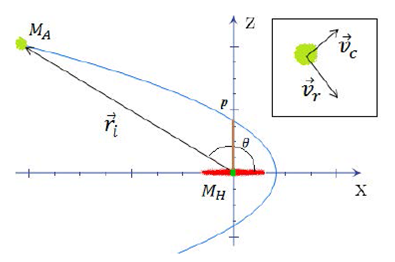
Figure 1 Scheme of the kinematic model of the association (green color and located in MA) in its fall towards the Milky Way (with the disk of the galaxy in red and the spheroid in green, located in MH) following a parabolic orbit. The Milky Way is located at the origin of coordinates and the center of mass of the association of dwars in. The brown segment indicates the location of the impact parameter p.
Results and discussion
Virialization of the initial objects. Figure 2 shows the results of the virialization of the dark matter-free dwarf galaxy with initial conditions generated in GADEGT-2. The final snapshot of the simulation can be seen to the left of the figure, preserving its spherical shape after 2 Gyr; on the right, the energy curves are shown as a function of time. Total kinetic energy (green), total potential energy (red), and the sum of kinetic and potential energies (blue) show that the structure is in virial equilibrium.
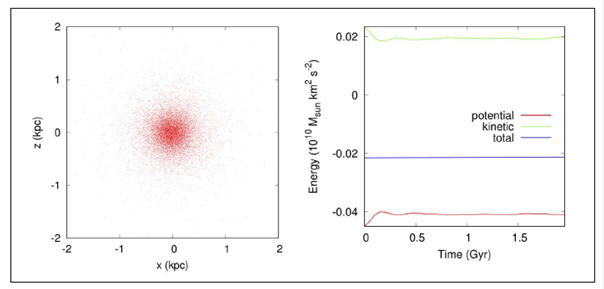
Figure 2 Results obtained from the virialization of the initial conditions for a dark matter-free dwarf galaxy. To the left, the snapshot of the virialized spheroidal structure. To the right, the energy curves in units of GADGET-2 as a function of time
Figure 3 shows the results of the virialization of the dwarf galaxy surrounded by a halo of dark matter with initial conditions generated using ZENO. The final snapshot of the simulation (green) + halo (red) can be seen the left, with virial radius dimensions according to the calculated values; the curves of the halo + spheroid energies can be seen to the right: total kinetic energy (green), total potential energy (red) and the sum of kinetic and total potential energies (blue), which also show that the structure is virialized as in the case of the dark matter-free dwarf galaxy in Figure 2.

Figure 3 Results obtained from the virialization of a dwarf galaxy wrapped in a halo of dark matter with initial conditions generated with ZENO and virialized with GADGET-2. Left: Snapshot of the virialized stellar content of the dwarf spheroidal structure (green) and its extended halo of dark matter (red). Right: The curves of energies in units of GADGET as a function of time (Benavides & Casas-Miranda, 2018)
Figure 4 shows the result of the virialization simulation of a disk galaxy with characteristics similar to those of the Milky Way. The figure on the right shows the kinetic energy (green), potential energy (red) and total energy (blue) as functions of time. The leftmost panel shows the virialized disk and bulge projected on the xy plane, while the central panel shows the virialized dark matter halo and the disk projected on the xz plane. It can be noticed that, after initial large energy exchanges, the objects are stable, i.e., virialized.
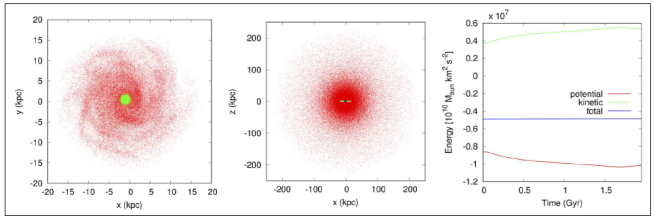
Figure 4 Results of the virialization of a disk galaxy with the properties of the Milky Way. The leftmost panel shows the disk (red) and the spheroid (green); the entral panel shows the whole galaxy (red: dark halo, green: disk, blue: spheroid). To the right, we can see the energy as a function of time.
Infall of associations located initially at 4 and 2 Mpc. We performed simulations for the infall of associations with initial galactocentric distances of 2 and 4 Mpc following parabolic orbits, and found that these associations would need more than a Hubble time to fall into the halo of the Milky Way and, therefore, to start orbiting it. Thus, it is very unlikely that associations located farther than ~1 Mpc could have originated the DoS of the Milky Way. The following results are for associations initially located at 1 Mpc from the center of the Milky Way.
Infall of associations of dark matter-free dwarf galaxies. To calculate the initial orbital conditions of the center of mass of the dwarfs making up the association, we took the angle θ as the parameter to obtain an impact parameter p of the order of half the radius of the halo of dark matter of the Way Milky. We calculated the initial velocities for the established orbit from the value obtained for the impact parameter and the masses of the objects (association + Milky Way). The dwarf galaxies interacted gravitationally with each other and with the potential of the Milky Way during the whole simulation. We used an initial angle of 150°
and an impact parameter of 134 kpc. Figure 5 shows the final snapshot of a simulation with an initial galactocentric distance of the association of 1 Mpc. From the figure, we can conclude that the remnant dwarfs are not located on a plane- like structure since both the positions projected on the xy and the yz planes show a very scattered pattern.
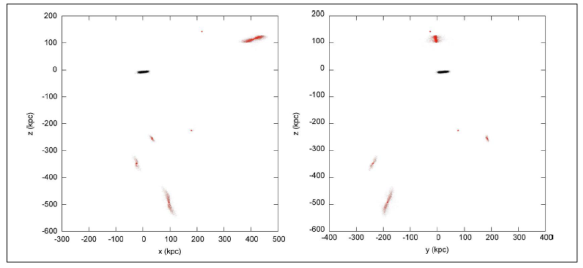
Figure 5 Final snapshot of a simulation with an initial galactocentric distance of the association of 1 Mpc, an initial angle of 150° and an impact parameter of 134 kpc. In red: Remnants of the dwarf objects. In black: the Milky Way’s disk.
Figure 6 shows that the dwarf objects remained compact and the apparent dispersion of particles in the final snapshot was due to a resolution issue of the image and not to a significant loss of particles or deformation by tidal forces. Thus, these dark matter-free dwarf galaxies do not reproduce some intrinsic properties of the observed dSphs of the Milky Way such as their mass-to-light ratio, internal velocity dispersions and luminosity profiles. Table 3 shows the location of the dwarfs and their velocity dispersions. In addition, with those initial conditions none of the dwarfs managed to complete a closed orbit during the simulation time (10 Gyr), which is an unfavorable fact because some of the DoS dwarfs are considered to have completed 2 to 3 full orbits (Law, et al. , 2005; Łokas, et al. , 2013).
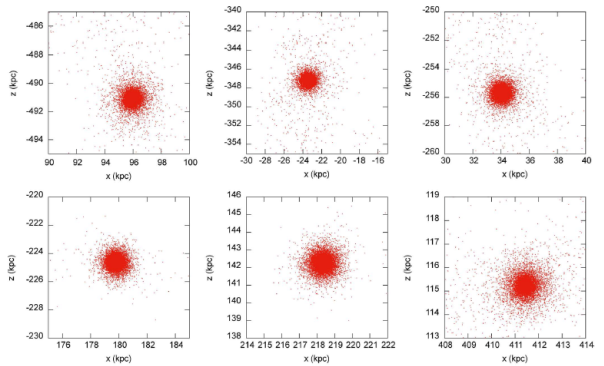
Figure 6 Zoom in of the remaining structures after the infall of an association of six dwarf galaxies candidate to be the progenitor of the disk of satellites of the Milky Way, projected on the xz plane.
Table 3 Results obtained for the kinematic properties of the association of dwarf galaxies that falls into the halo of the Milky Way from an initial distance of 1 Mpc

Therefore, the associations of dark matter-free dwarf galaxies initially located at 1 Mpc from the center of the Milky Way following the parabolic orbit simulated in this work cannot have given origin to the disk of satellites of the Milky Way.
Infall of associations of dwarf galaxies with a dark matter halo. Figure 7 shows the final snapshot of a simulation with an initial galactocentric distance of 1 Mpc, an initial angle of 150° and an impact parameter of 134 kpc. In this case, each of the stellar structures is embedded in a dark matter halo. In the figure we can see that the positions of the dwarfs projected on the xz plane are scattered over a large region, while the positions projected on the yz plane lie on a very narrow region. Therefore, it can be concluded that the remnants of the initial dwarf galaxies lie on a plane that is nearly perpendicular to the plane of the galactic disk (xy plane).
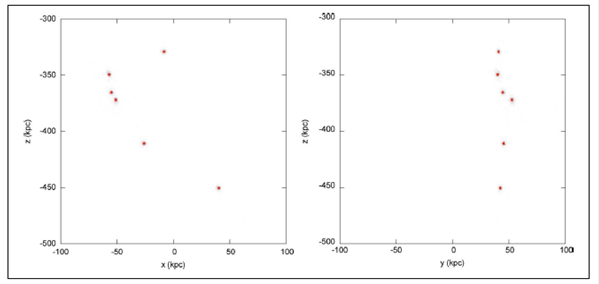
Figure 7 Final snapshot of a simulation with an initial galactocentric distance of the association of 1 Mpc, an initial angle of 150°, and an impact parameter of 134 kpc. Each dwarf galaxy is embedded in a dark matter halo (not plotted). The remnants of the stellar components of the dwarf objects are plotted in red.
Comparing Figure 6 and Figure 8 we can see that when the dwarf galaxies contain dark matter they remain more compact than when they are free of dark matter.

Figure 8 Zoom in for the set of six dwarf galaxies wrapped in a halo of dark matter after 10 Gyr of infall towards the halo of the Milky Way from an initial distance of 1 Mpc, projected on the xz plane.
Table 4 shows the location of the dwarfs and their velocity dispersions. We can see that these properties are consistent with those observed in the dwarfs of the disk of satellites of the Milky Way, presenting a distribution perpendicular to the plane of the galactic disc, although less dispersed than in the case of dark matter-free dwarfs. In addition, their radial distances are greater than the 300 kpc at which most of the dwarf galaxies of the disk of satellites are found.
Conclusions
Regarding the formation of the disk of satellites of the Milky Way, we discarded associations of dwarf galaxies initially located at distances equal or greater than 2 Mpc because their time of infall was larger than a Hubble time. We can also state that associations of peripheral galaxies located at these distances from the Local Group cannot be considered as objects that could be part of the disk of satellites in the future.
As for the morphology of the dwarf galaxies, after 10 Gyr of interaction with the Milky Way we observed that if they are surrounded by a dark matter halo they remain more compact despite the effects of tidal forces, which supports the hypothesis of the presence of dark matter in dwarf galaxies.
In terms of the location distances of the simulated dwarf galaxies around the Milky Way, we can conclude that the distances at which they were located were better adjusted to the dark matter-free model for the dwarf satellites, since most of the galaxies are at galactocentric distances ranging between 280 kpc and 500 kpc and, in that case, the formation of a disk of satellites could not be reproduced in the present study. Thus, with the parameters used in this study it is unlikely that the satellites of the DoS come from dark matter-free associations of dwarf galaxies that fall into the Milky Way halo.
On the other hand, we were able to reproduce a disk- like spatial distribution of the remnants of the initial objects when embedded in a dark matter halo, which supports the widely accepted hypothesis about dark matter content in dwarf galaxies. Thus, we have shown that it is possible that a feature like the DoS could have been formed from the infall of associations of dwarf galaxies embedded in dark matter haloes following parabolic orbits. However, the distances of the remnants to the center of the Milky Way at the final snapshot do not reproduce the distances reported in the literature for the satellites of the Milky Way.
This discrepancy could be solved with a larger simulation time, and by selecting the final time of the simulation as that one in which the distances of the simulated objects are close to the observational ones, as well as by fine-tuning some quantities like the initial dark matter content of the association, the number of complete orbits the satellites should have done, the velocity dispersions and their circular velocities around the Milky Way.



















